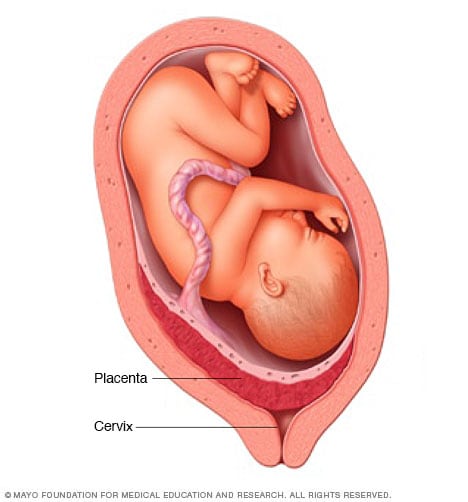Placenta previa
Placenta previa
overview
Placenta previa

Placenta previa
The placenta is an organ that develops in the uterus during pregnancy. In most pregnancies, the placenta attaches to the top or side of the uterus. In placenta previa, the placenta attaches deep in the uterus. The placenta can partially or completely cover the opening of the uterus, called the cervix. Placenta previa can cause severe bleeding in the mother before, during or after birth.
Placenta previa (pluh-SEN-tuh PREH-vee-uh) is a problem during pregnancy when the placenta completely or partially covers the opening of the uterus (cervix).
The placenta is an organ that develops in the uterus during pregnancy. It serves to provide the baby with oxygen and nutrients and to remove waste products. The placenta is connected to your baby via the umbilical cord. Typically, the placenta is attached to the top or side of the inner wall of the uterus.
In placenta previa, the placenta attaches deeper in the uterus. This causes some of the placental tissue to cover the cervix. Bleeding may occur during pregnancy or during or after birth.
Changes in the uterus and placenta during pregnancy may cause the problem to resolve on its own. If this is not the case, the baby will be delivered via cesarean section (cesarean section).
Symptoms
The main sign of placenta previa is bright red vaginal bleeding, usually without pain, after 20 weeks of pregnancy. Sometimes spotting occurs before an event with more blood loss.
The bleeding may occur during contractions of the uterus before birth, which cause pain. Bleeding can also be triggered by sex or during a medical exam. For some women, bleeding may not occur until after birth. Often there is no clear event that causes bleeding.
When to go to the doctor?
If you experience vaginal bleeding during your second or third trimester, contact your doctor immediately. If bleeding is severe, seek emergency medical attention.
Causes
The exact cause of placenta previa is unknown.
Risk factors
Placenta previa is more common in women who:
- Habe ein Baby bekommen
- Hatte eine frühere Kaiserschnittgeburt
- Narben an der Gebärmutter von einer früheren Operation oder einem früheren Eingriff haben
- Hatte Plazenta praevia bei einer früheren Schwangerschaft
- schwanger sind, nachdem sie sich einem Verfahren der assistierten Reproduktionstechnologie (ART) zur Behandlung von Unfruchtbarkeit unterzogen haben
- Tragen mehr als einen Fötus
- 35 Jahre oder älter sind
- Rauch
- Verwenden Sie Kokain
Complications
If you have placenta previa, your doctor will monitor you and your baby to reduce the risk of these serious complications:
- Blutung. Während der Schwangerschaft, der Geburt, der Geburt oder in den ersten Stunden nach der Geburt können schwere, möglicherweise lebensbedrohliche Blutungen aus der Scheide (Hämorrhagie) auftreten.
- Frühgeburt. Schwere Blutungen können zu einem Notkaiserschnitt führen, bevor Ihr Baby voll ausgetragen wird.
- Spektrum der Placenta accreta. Placenta praevia ist mit einer Gruppe von Erkrankungen verbunden, die als Plazenta-accreta-Spektrum bezeichnet werden. Unter diesen Bedingungen wächst die Plazenta in oder durch die Gebärmutterwand. Placenta accreta hat ein hohes Blutungsrisiko während der Schwangerschaft oder während und nach der Geburt.
Sources:
- Resnik R. et al., Hrsg. Plazenta praevia und accreta, Vasa praevia, subchorionische Blutung und Abruptio placentae. In: Creasy und Resniks Maternal-Fetal Medicine: Principles and Practice. 8. Aufl. Elsevier; 2019. https://www.clinicalkey.com. Abgerufen am 16. Februar 2022.
- Lockwood CJ, et al. Plazenta praevia: Epidemiologie, klinische Merkmale, Diagnose, Morbidität und Mortalität. https://www.uptodate.com/contents/search. Abgerufen am 16. Februar 2022.
- Lockwood CJ, et al. Plazenta praevia: Management. https://www.uptodate.com/contents/search. Abgerufen am 16. Februar 2022.
- Placenta praevia. Merck Manual Professional-Version. https://www.merckmanuals.com/professional/gynecology-and-obstetrics/abnormalities-of-pregnancy/placenta-previa. Abgerufen am 16. Februar 2022.

 Suche
Suche
 Mein Konto
Mein Konto